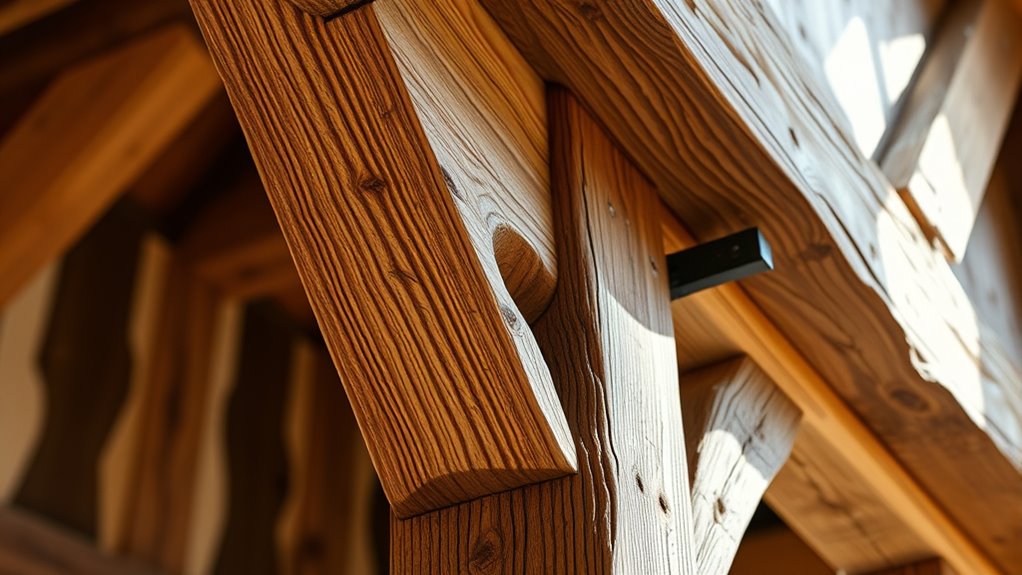Timber framing terminology may seem complex at first, but understanding key terms like “bent,” which is a combined frame section, or “mortise and tenon,” a classic joint, helps you see how craftsmen build strong, lasting structures. Recognizing these joints and terms reveals the skill behind traditional woodworking techniques. Once you get familiar with these concepts, you’ll better appreciate historic buildings and their craftsmanship—there’s plenty more to discover about these timeless methods.
Key Takeaways
- Learn common timber framing terms like “bent,” “mortise and tenon,” and “king post” to understand construction plans better.
- Familiarize yourself with traditional joinery techniques that rely on craftsmanship rather than metal fasteners.
- Recognize how joints are crafted for strength and aesthetic appeal, often lasting centuries without nails or screws.
- Understand the historical development of joinery methods to appreciate their durability and craftsmanship.
- Use this knowledge to interpret historic building plans and support preservation or restoration projects.

Have you ever wondered what sets apart traditional timber framing from other construction styles? One of the key differences lies in the joinery techniques used to connect the timber members. Unlike modern framing, which often relies on nails, screws, or metal fasteners, timber framing employs carefully crafted joints that are both functional and aesthetically pleasing. These joints, such as mortise and tenon, half-lap, and dovetail, are designed to fit together snugly, creating a sturdy framework that can last for centuries. Understanding these joinery techniques helps you appreciate the craftsmanship behind historic buildings and recognize how they provide strength and stability without relying on modern hardware.
Traditional timber framing uses crafted joints like mortise and tenon for lasting strength and beauty.
As you explore timber framing, you’ll quickly encounter a variety of historic terminology that describes the different parts and processes. Words like “bent,” which refers to a curved or straight assembly of timbers forming a section of a frame, or “king post,” a central vertical support in roof trusses, might seem unfamiliar at first. These terms have been passed down through centuries of craftsmanship and often appear in traditional building plans and restoration projects. Recognizing and understanding this terminology allows you to read old construction documents with confidence and better appreciate the intricacies of traditional timber framing. It also helps you distinguish between different types of joints and their purposes, deepening your knowledge of how these structures stand the test of time.
Traditional timber framing isn’t just about the joints and terms; it’s a reflection of centuries of building knowledge. The techniques used were often developed through trial and error, refined over generations to maximize strength while minimizing material waste. Many of these joinery techniques are so precise that they require no nails or metal fasteners at all, relying instead on carefully cut joints that interlock. This craftsmanship also influenced historic terminology, where specific words described particular joints, tools, and construction methods. Learning this language not only demystifies the process but also connects you to the builders of the past, whose skill and ingenuity laid the foundation for many enduring structures. Additionally, understanding joinery techniques can help preserve historic buildings and inform modern sustainable construction practices.
Understanding timber framing terminology and joinery techniques empowers you as a beginner. It enables you to appreciate the artistry behind each joint, recognize the significance of historic terminology, and see how these methods have shaped architectural history. Whether you’re interested in restoration, carpentry, or simply exploring the beauty of traditional structures, mastering these foundational concepts makes your journey into timber framing more meaningful and engaging. It’s a gateway to appreciating craftsmanship that has stood the test of time and a step toward preserving this ancient, sustainable building art for future generations.
Frequently Asked Questions
How Do I Identify Different Types of Timber Joints?
To identify different timber joints, look for key features like the mortise and tenon, where a projecting tenon fits into a mortise hole, creating a strong connection. Scarf joints, on the other hand, are long, tapered cuts that join two timber pieces end-to-end. Pay attention to the shapes and how the pieces fit together, as these clues will help you distinguish between various joint types used in timber framing.
What Tools Are Essential for Timber Framing?
Imagine building a puzzle; your tools are the pieces that connect everything. For timber framing, vital tools include a saw, chisel, square, and hammer. Proper wood selection guarantees stability, while safety equipment like goggles and gloves protects you from potential injuries. These tools help you craft precise joints and secure structures. Without them, your project’s foundation would be shaky, just like a puzzle missing essential pieces.
How Does Climate Affect Timber Framing Techniques?
Climate impact plays a vital role in timber framing techniques. You need to adapt your methods to manage moisture control, especially in humid or wet environments. By selecting appropriate wood types and applying protective finishes, you prevent rot and warping. In dry climates, you might focus on insulation and ventilation. Understanding your local climate helps you build durable structures that withstand weather challenges and maintain their integrity over time.
What Are Common Mistakes Beginners Make in Timber Framing?
When starting with timber framing, you might choose the wrong timber or overlook load-bearing capacities, leading to weak structures. You tend to rush the planning stage or misjudge the strength needed, which can cause stability issues. Always understand load-bearing capacities and select the right timber for each part. Take your time to learn proper joinery techniques and avoid rushing, as these mistakes can compromise your entire project’s safety and durability.
How Can I Learn to Read Timber Framing Blueprints?
Perfecting your blueprint reading skills begins with patience and practice. Focus on familiarizing yourself with wood species and joinery styles, which are fundamental to understanding timber framing plans. Start with simple drawings, study symbols, and annotations carefully. Watching tutorials, using reference guides, and practicing with real blueprints build confidence. Over time, you’ll decode complex diagrams, making your timber framing projects more precise and enjoyable.
Conclusion
Now that you’ve learned the basics of timber framing terminology, you’re better equipped to appreciate these historic craft. Did you know that over 80% of traditional structures still standing today feature these techniques? Understanding these terms helps you see the artistry behind each joint and beam. Keep exploring, and you’ll soon recognize the beauty and precision in every timber frame, making your journey into woodworking or historic preservation even more rewarding.









